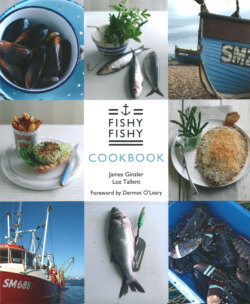Читать книгу Inspired Star Block Quilts - Paul Shovlin - Страница 18
На сайте Литреса книга снята с продажи.
Fishing for cod
ОглавлениеIf you love fish – and more importantly, if you care about fish stocks – then at some point you are going to have the ‘cod conversation’. Much like tuna, cod is the media darling of the fishing world. Conservationists say stocks are running low and that we should not eat it, while the fishermen say that there is so much of it they can’t help but catch it and end up having to throw it back overboard. You will see it on a menu, or at the fish and chip shop and think to yourself ‘do I, or don’t I?’
The solution to this problem is to make an informed decision. The most important thing a fish lover needs to know about cod is that it is seasonal. It likes cold, choppy waters so goes wherever it can find them. Therefore it’s in and around the British inshore waters in the winter, moving to deeper colder waters in the summer. So if you eat cod all year round, then you are not giving the stocks time to recover from being fished. The only way to eat cod with a clear conscience is to make sure it is always fresh and always locally caught. It’s also important to know how it was caught. Deep-sea trawlers have no choice in what size they catch (apart from small fish that are able to get through the nets) and although they know where certain fish are they can’t guarantee catch. Tidal gill nets are a much more sustainable way of fishing for cod.
It’s 5.30am on a blustery morning in the port of Shoreham, East Sussex, when skipper Gary Brownrigg, along with mate Peter Budden, starts up the engine of the Catherine Ann and sets off to check on the nets. He’s after cod. There is a small quota for this winter – about ten tonnes, so he only puts his nets out when the price is good. He can charge a premium because of the quality of the fish he catches. He nods at the fish market, as he passes, already a bustle of activity preparing for the arrival of the day’s catch.
As he leaves the harbour the swell picks up – nothing to worry about, but his mind returns to when a sudden storm actually flipped the boat over. Fishing is dangerous. There’s no point going out when it’s really rough, the rocks and stone are thrown around so much they get caught in the nets, ruining them.
Gill nets are a very sustainable way of catching cod. They’re placed on the seabed like a tennis court net but the strong current keeps them flat on the bottom until the slack tide, when the nets rise up ready to catch the fish. The tide takes about an hour to turn and the net will then be pushed back onto the seabed. So the nets only fish for a couple of hours a day. They have big holes to let the smaller fish through and although Gary knows where the fish are, they’re not stupid – they can see the net and the clever ones simply swim around it.
He pulls and re-sets five nets off the Sussex coast, all inshore where he knows the bigger fish will be and lands a good catch of cod, as well as some ray and Dover sole. He’s also caught a few cuttlefish but these will go straight to Spain as there is no market for them in the UK. As noon approaches the last net is set – it’s been a good day so he heads back to the safety of the harbour for a mug of tea and a bacon sandwich.
